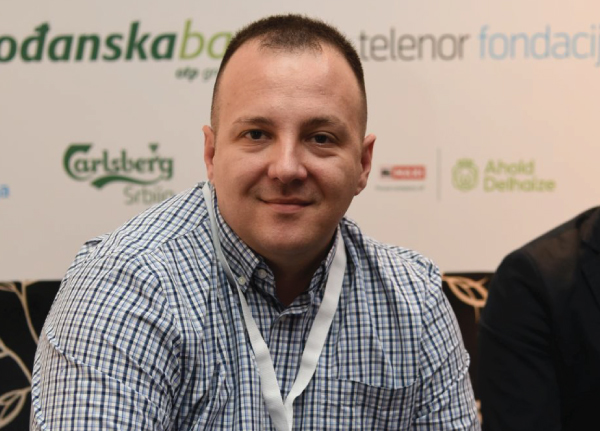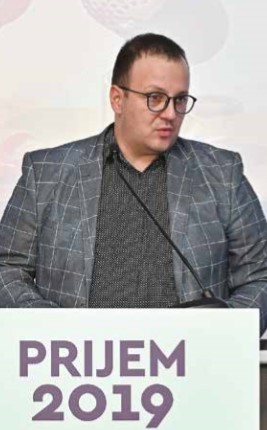As creativity grows, budgets decline. Plus, getting paid in Serbia is a very slow process. There is also the fact that the Serbian market is very small. Considering all of this, our optimism becomes highly questionable

Nowadays, it’s not easy to be a professional PR manager since there are many challenges. We talked with the Chairman of the Managing Board of the Public Relations Society of Serbia, Dušan Stojaković, how to deal with and how to overcome all these challenges, as well as whether the solution lies in certification.
Can public relations in Serbia today be called an established, regulated profession?
— On the one hand, it seems that public relations is a well-founded and regulated profession if we are talking about legal regulation; although I have reservations when it comes to its full implementation and adequate interpretation. Of course, it is always possible to update the laws and continually adapt them to the objective interests of the public, with the highest degree of ethics in the profession. On the other hand, media sensationalism, which is a purpose in itself solely for the sake of greater readership, is spreading just as much as the diminishing professionalism of PR and media staff. And so we come to the situation that certain media and certain PRs are becoming the simulacrum of Jean Baudrillard, with little or no connection to reality. Simply, we must now allow just anyone to do media and PR work! That’s in the general interest of society.
How would you rate the year 2019 for PR and creative industries?
— This business year has probably been one of the most challenging so far. It was not easy. The use of modern technologies has created ever greater opportunities for creativity, with the ever-increasing trend of budget cuts, which directly affects quality. As creativity grows, budgets decline. Plus, getting paid in Serbia is a very slow process. There is also the fact that the Serbian market is very small. Considering all of this, our optimism becomes highly questionable. Still, one needs to focus on capabilities, just like in a SWOT analysis. Innovations brought to us by the creative industries, both technical and technological, as well as aesthetic and communicative, should be our new playground on which to experiment, explore and give new meaning to communications. In this respect, creativity, digital and integrated are the three key concepts. Everything is content today, while context is also becoming increasingly important. The interpretation of the context should start very basically – as a well-recognized and at least partially satisfied taste of the audience at the right time. Does this sound like a story about influencers to you?
How is this affecting public relations and how much pressure is there to keep up with this progress?
— Just like human needs, the manner and means of communication are changing rapidly. In a time when our roles in life are becoming multifold and complex, where both our and others’ expectations are increasing, with having less time for ourselves and others, I am sure that you will agree with me that good, quality, timely, efficient and agile communication is the only or one of the essential success formulas. When my parents were at the height of their careers, their workday consisted of a few received faxes, and mine, just like yours, means at least 100 received and sent emails a day. It doesn’t make sense to compare, does it? Digitization, the queen of real-time dialogue, knowing no obstacles relating to distance or number of participants, has brought about the biggest revolution in the field of public relations, bridging all limits of television and conventional media. Remember that we live in the post-era of the Fourth Industrial Revolution. They say that establishing a relationship with your target group is not possible unless you are “carried in a pocket” of those people you want to reach out to and unless you communicate on platforms designed for mobile phones and smart devices. Back in the day, the rule of thumb was if you’re not in the media, it’s like you don’t exist. Today, the rule is if you are missing out on digital platforms, i.e. on the digital, you don’t exist.
What are the biggest challenges the PR industry faces today?
— An adequate response to digitization and digital trends, continuous education and restoration of professionalism in the PR industry. Superficial interest and shortened attention span, with very narrow perceptions, are part of the ecosystem in which modern generations are growing up and in which PRs exist. Recently, I asked my students a simple question: what is a hashtag? Naturally, everyone knew it was a symbol you put in front of the chosen word. And that’s all they knew. There are many such examples. Young people understand the world around them only a priori experientially, but not theoretically and truly empirically. Also, we are faced with the norms imposed by banal popular culture and cheap media content. But to get back to the your question – the biggest challenge for the profession today is how to bring quality back to the communications world. This is only possible through practising strong ethics, personal and professional integrity and uncompromising morale, which excludes any type of flirtation – corporate, political or other. And, of course, making it clear that not everyone can or should engage in PR work. Today, people use terms like “written” („pisan“, in the Serbian language) and “literate” („pismen“ in the Serbian language) in the same context (as in submitting something in a written form or writing). When they use the term „in the literate form“ for submitting something in writing, I ask them is it possible to submit something in the „illiterate“ form?! So language, like communications, is a category that constantly evolves. It is up to us, PR professionals and our future colleagues whether, one day, a nonsense word, emoticon or abbreviation will become so familiar in the spoken language that it ultimately becomes formally acceptable.

We are bombarded daily with thousands upon thousands of pieces of information and varied content. How do you stay authentic and retain your audience?
— Bombing someone with thousands upon thousands of press releases will earn you money and help you to survive, which is something you are entitled to. However, if you offer the public a dozen bombastic pieces of information and news headlines on the front page or in prime time, which hide distorted and “photoshopped” truth, and often, which is my favourite topic, fake news, then your readers or viewers will quickly lose their trust in you. I am talking about viewers and readers who are capable of thinking for themselves. Credibility suffers too. In the long run, this is what shortens the life cycle of the media and when trust disappears there isn’t a fantastically sensational piece of news that can bring such media outlet back to life. For me, the keyword is balance – both what the media places on us and what we perceive from their content. Authenticity is achieved by quality, and quality guarantees the existence of clear and meaningful messages of communication, without deliberate or accidental “noise”.
How important is for companies and brands today to know their target group well and what does it all entail?
— Brands do not belong to companies, but to their customers. Imagine if everyone stopped drinking their favourite dark carbonated beverage all at once? All factories, marketing / PR and big inventory would be useless. There are no brands without consumers. The digital environment has provided an opportunity for praise and criticism, and people are more inclined to criticize. I doubt that companies and brands know their target groups well enough. Often in business, when I ask the question “who is your target group”, companies respond with “everyone”. Aside from the fact that companies need to know their customers and their habits, it is important that they also know their lifestyles and needs well. Marketing and communications, by themselves, do not create needs, but they help people bring certain products or services closer to their needs. Accordingly, knowing your target group is essential. Let’s not forget the infamous thing called big data. So many professionals have talked about big data but nothing happened with it in the end because when we discovered a phenomenon called big data and realized its importance, we did not know what to do with it. We stopped at big analytical data and have failed to implement those analytical results in our business and communication strategies.
How important is education for both beginners and seniors?
— Education is essential for both beginners and seniors. It offers beginners what they miss at the beginning of their careers – experience that will ensure a stable and promising career for them. As for seniors, it gives them a continuous connection to the latest trends, which allows them to “stay in the business”. As of next year, DSOJ will provide a type of vocational education through the certification of PRs. In addition to updating their knowledge, everyone involved in public relations will also have the opportunity to test their knowledge and prove that they are worthy of a PR certificate, which gives them an advantage over those individuals who are self-proclaimed PRs, who are, by the way, growing in numbers. We will announce the beginning of the certification process in late October at our #Prilika2019 conference. The certification process is modelled after the regional countries, with multiple levels on offer for both PR beginners and established PRs. The direct benefits of certification are obvious and include less ill-conceived press releases that are of no interest to the media or the public; more well-profiled and conceptualized key messages that everyone wants to hear/see; fewer “why didn’t they publish my press release” interventions, etc. Certification for PRs, as well as their employers, should pose as a seal of quality and validation of credibility in public relations.
What is the future of public relations in Serbia?
— There are several scenarios and they all depend on us – current and future PR professionals. One scenario is that PR will be increasingly integrated into HR, which, at first, may seem meaningful, but it is short-lived, i.e. until the first PR crisis. Another, a much more desirable, scenario is restoring the profession’s old glory, which is only possible by raising professional standards, education, positive selection and bringing order to the world of communications and public relations, as well as the media. The average person has only a few seconds to read or watch the news, just as much time as a journalist or editor has to look at a press release. So, let’s offer them the quality that will ensure continuity; to the general satisfaction of both the public, the media, brands and, last but not least, PR professionals.